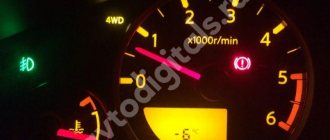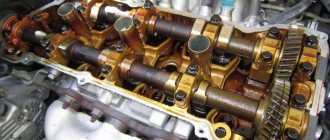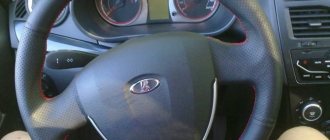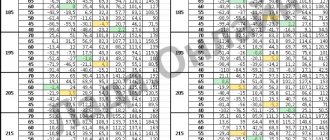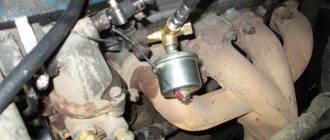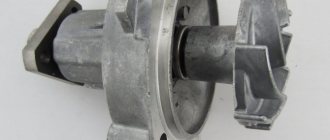| Place | Name | Characteristics in the rating |
| The best batteries for VAZ 2114, 2115 |
| 1 | VARTA Blue Dynamic 60 Ah 540A | Long service life |
| 2 | BOSCH S4 Silver 60 Ah 540A | Best quality. Holds a charge for a long time |
| 3 | Akom 60 Ah 520A | The most reliable battery |
| The best batteries for VAZ 2110 |
| 1 | MUTLU SFB M3 63 A*h 550 A | High performance. Modern protection against counterfeiting |
| 2 | FORSE 55 Ah 530 A | Excellent resistance to low temperatures. High safety margin |
| 3 | Exclusive 6ST 60 A*h 500A | Best price |
| The best batteries for Lada Kalina |
| 1 | Energizer Plus EP95JX 95A*h 830A | Best Features |
| 2 | E-LAB 62 Ah 580 A | High durability |
| 3 | TIMBERG PROFESSIONAL POWER 60 Ah 480 A | The best ratio of price and quality |
| The best batteries for Lada Priora |
| 1 | TOTACHI CMF 60 Ah 540 A | Long service life. Low self-discharge |
| 2 | AkTech AT 77-Z-L 77A*h 680A | The most popular battery among VAZ owners |
| 3 | BEAST 60Ah 600A | Highest starting current |
The best batteries for VAZ 2114, 2115
Reliable and unpretentious domestically produced cars, the VAZ 2114 and its analogue, the VAZ 2115 sedan, are factory equipped with a battery with a capacity of 55 Ah. The on-board network is designed specifically for these parameters. At the same time, when buying a new battery, the owner can safely choose models with 60-62 Ah, the advantage of which will become obvious in winter frosts. In addition, the batteries must have straight polarity (the “+” terminal is on the left) and the appropriate dimensions to easily fit on the battery tray under the hood. The best batteries with the specified parameters are presented in this category.
Problems with batteries in VAZ models
The battery in a car is the main source of autonomous power. Starting the engine depends on its reliability and performance. The quality of battery charging has a particularly significant impact on this process if the power unit is of the injection type. Also, from the on-board network, which is powered by the battery when the engine is not running, all electrical consumers in the car receive energy: radio, interior and trunk lighting, headlights, cigarette lighter, and so on.
But often a car owner is faced with the fact that for some reason various kinds of problems arise with the battery. Let's take a closer look at possible battery malfunctions that may arise during its operation and how to eliminate them.
The battery indicator lights up on the instrument panel
All instrument panel indicators light up when the engine is started and go out after a few seconds if all vehicle systems are in good condition. The reason that the warning light continues to light may be:
- Poor contact or lack of ground wire. It is necessary to check that the wire is securely fastened to the terminal marked with the “-” symbol.
- A break in the vehicle's on-board network. Using a multimeter, “ring” all the electrical wiring of the car network.
- The electrolyte level in the banks is below normal. Carry out battery diagnostics, measure the level of the electrolyte solution, and top it up if necessary.
- Low tension on the alternator belt due to wear or damage. Replace the belt or return its tension to normal.
- Oxidation of battery contacts or generator terminals. Inspect the battery, make sure there is no characteristic plaque on its terminals.
- Damage to the battery, leading to a leak in the case, which is usually accompanied by a characteristic smell of rotten eggs. Inspect the battery housing, if leaks are detected, identify their cause and eliminate it.
- The fuse has blown or there are problems with the relay or diode bridge. Check the charging level of the current source with the engine running: if it is normal, then the voltage will be in the range of 13.6–14.2 Volts.
- Battery casing is swollen. Carefully inspect the battery and replace it if swelling is detected.
The battery is not charged when the engine is started (the battery indicator does not light up on the instrument panel)
There may be several reasons for this:
- Oxidized battery contacts. Clean the contacts by turning off the engine and disconnecting the battery from the vehicle network.
- Malfunction of the wire connecting the battery to the generator. Replace the wire.
- There is a breakdown in one of the diode bridges. With the ignition on, use a multimeter to check the serviceability of all diodes.
- Malfunction of the generator itself. You can detect a problem in the winding as follows: disconnect the wire from the generator terminal and connect it to the car body, which will act as a “ground”. If the battery indicator on the dashboard lights up, then the cause has been found.
- When connecting, the battery terminals were reversed. If you carelessly install the current source, situations sometimes occur that when connecting the terminals, they are swapped.
Fast battery discharge
A battery can self-discharge due to various factors:
- Incorrectly selected battery capacity:
- if it is lower than that of the standard battery, then when driving in a traffic jam with electrical consumers turned on, the battery will quickly lose charge due to low voltage in the network;
- if significantly higher, then the generator will not be able to provide the necessary battery recharging.
- Lack of contact in the battery-generator circuit. Check the fastening of the wires, as well as the presence of oxidation of the contacts. If necessary, they should be cleaned.
- The battery life is reaching the end of its life. Even with proper operation and proper care, the battery has a certain service life. The longer the current source is in operation, the smaller its capacity becomes, and consequently, the charging volume decreases.
- Frequent battery discharges to zero. If you allow the battery to be completely discharged several times, it will discharge very quickly in the future. This is due to the fact that if it is completely discharged, it will no longer be possible to restore the charge to 100%. That is, each time the battery loses part of its nominal capacity set by the manufacturer.
- The car is used to travel only short distances. In this case, while driving, the battery will not have time to replenish the energy lost when starting the engine, which contributes to its rapid and frequent discharge.
- Low outside temperatures. In the cold season, the battery tends to run out much faster than in the warm season. Especially if the car is not used for a long time.
- Low electrolyte level. Regular maintenance and constant monitoring of the level of solution poured into the battery will help solve the problem.
- The voltage regulator is faulty. Check the device for functionality using a multimeter.
- The timing belt has stretched too far. To fix this, you will need to replace the timing belt.
- Recharging the battery with high currents. If necessary, restore the battery charge using a charger. The charging current should be set correctly, which should be no more than 10% of the nominal battery capacity. If you charge the battery with currents whose magnitude significantly exceeds the established limit, this can provoke destruction of the plates and constant discharge of the battery.
The best batteries for VAZ 2110
To understand which battery is best suited to the on-board network of the VAZ 2110, the owner needs to take into account the influence of the following factors: the type of starter, the actual power of the generator, the nature of the upcoming operation and the presence of additional electrical equipment on board the car. The factory equipment includes a battery with a capacity of 55 Ah and a cold starting current of 255 Amperes. For more confident operation, you can take a battery with a slightly larger capacity (5 - 7 A*h), and the starter current can reach 500-550 A.
Device and principle of operation
A conventional 12 V battery is a set of individual 2 V cells assembled in one case and connected to each other in a series manner.
Components:
- a battery bank consisting of negative and positive plates separated from each other by acid-resistant separators;
- body made of ebonite or acid-resistant plastic with molded compartments for placing cans;
- pole plates in the form of lead cellular grids with a pressed-in active substance of a porous structure to increase the contact surface with the electrolyte;
- active substance from lead powder with additions of sulfuric acid or barium sulfate, depending on the polarity of the plates. When forming, charging occurs. In positive conditions it is converted into lead dioxide, in negative conditions it is converted into spongy lead;
- an electrolyte consisting of a solution of sulfuric acid in distilled water, having a density of up to 1.29 shg/cm3 at a temperature of + 25⁰C.
The principle of operation is the generation of electric current during electrochemical reactions of lead-containing elements. When there is an external load on the contacts, the interaction of the electrolyte with lead oxide begins. During a chemical reaction, sulfate is formed from lead metal. When discharged at the cathode, lead is oxidized, and lead oxide is reduced at the anode. When charging, the reverse process occurs. When lead sulfate is consumed, electrolysis of water occurs, and oxygen and hydrogen are released at the anode and cathode, respectively, creating a boiling effect. This should not be allowed due to an increase in the density of the electrolyte, water consumption and the risk of an explosion of the explosive mixture (oxygen and hydrogen).
To maintain the required electrolyte level, distilled water is added.
Primary requirements:
- ability to generate high current;
- slow self-discharge during operation;
- slight internal voltage drop;
- ease of maintenance;
- convenient sizes.
The best batteries for Lada Kalina
The manufacturer installs lead batteries with a capacity of 55 Ah on the Lada Kalina car. At the same time, the discharge current is only 255A (at -18°C). If replacement is necessary, you should focus on these indicators when choosing a battery. The new battery must meet standard dimensions and have straight polarity. The capacity may be slightly larger, but not significantly (a battery with parameters of 70-75 Ah will not have enough generator power to fully charge). The starting current should not be lower than specified (if it is higher, it will be easier to start in winter). You can find out which battery models are best suited for the Lada Kalina in the category below.
Characteristics
- Capacity in ampere-hours (A*h) - determines the amount of electricity supplied when discharging to the minimum permissible voltage level. When calculating, the discharge method is used for 20 hours with a current of 5% of the capacity value.
- Cold cranking current (starting current) is determined after the battery has been cooled to -18⁰C and discharged for 30 seconds. The operating voltage value must be greater than 8.4 V. When discharging in 150 seconds, the voltage must be greater than 6 V.
- Electromotive force - shows the voltage at the contacts of the product without external load and leakage, measured with a voltmeter or multimeter.
- Internal resistance - summarizes the resistance value of all battery elements: electrodes, separators, electrolyte, contacts and others. At lower values, the starting current is higher, which increases the reliability of starting the motor at low temperatures.
- Self-discharge - defines a spontaneous decrease in capacity caused by redox processes under no-load conditions. The self-discharge rate is influenced by the density and chemical composition of the electrolyte, temperature, plate material, cleanliness of the case, and service life.
- Shelf life – determines the length of time the battery remains in a dry-charged state before use.
- Polarity is determined by the location of the current-collecting contacts on the monoblock: the straight line has “plus” on the left, and “minus” on the right; the opposite is the case.
- Reserve capacity is determined by the time in minutes during which the battery will provide electricity in the event of an emergency.
As a rule, the voltage of a charged battery is from 15.5 to 12.9 V. The voltage in the on-board electrical network when the engine is running is slightly higher than at the contacts and ranges from 13.8 to 14.4 V. At a voltage less than 13.8 V, undercharging occurs , and more than 14.4 V – overcharge. Both have a negative impact on service life.
Battery selection
When choosing a new battery for the VAZ-2107, first of all you should understand its main functions. Since the second name of the battery is “starter battery,” this means that this particular element is responsible for starting the engine of the iron four-wheeled horse. In addition to this function, the battery allows you to power electrical equipment:
- glass wipers Which battery is better to choose for a VAZ-2107 car;
- front and rear lights;
- electric windows and so on.
Moreover, if the car’s generator fails and the battery is completely repaired, then this element will help the owners get the car to the right place. But in order for the battery to cope with its main purpose 100%, when choosing, you should take into account the most basic criteria:
- Polarity of your car. Since in the analyzed “classical” model the “+” terminal is located on the right side, to install a new battery you should use only the option that provides for straight polarity.
- When choosing a battery, you should study in advance the size of the area that the battery occupies. If you choose a smaller model, the element will not be reliably installed, which will negatively affect its functionality.
- The capacity size of the battery used is one of the most important criteria when choosing. For the VAZ-2107, you should use a battery option whose capacity size will exactly correspond to the engine model and the number of electrical appliances provided in the car. The size of the capacity, which is called reserve, must also be taken into account, because this element is responsible for the battery life in the event of a faulty generator, in offline mode.
- What kind of power system is used in the car should also be taken into account when choosing a new battery for the VAZ-2107. The fact is that on different models, manufacturers use different engine starts. For example, engine starting with carburetors is analyzed as more energy-intensive than with an injector. Taking this point into account, experts recommend choosing a battery of the largest possible capacity for the carburetor.
- For the VAZ-2107, experts recommend choosing a battery with an Ah rating of at least 50, so that in the future there will be no problems with the operation of the starter. Home craftsmen often install batteries with an even larger volume, but before doing this they replace the generator. The fact is that for normal operation of a large battery, a powerful generator is required.
- Taking into account the advice of experts, for normal operation of the VAZ-2107 engine, the battery must have a maximum starting current. It is this indicator that is responsible for the duration and reliability of the battery, especially in the winter.
